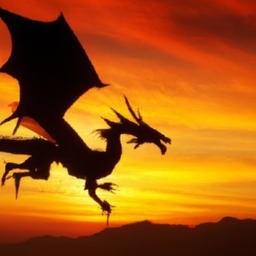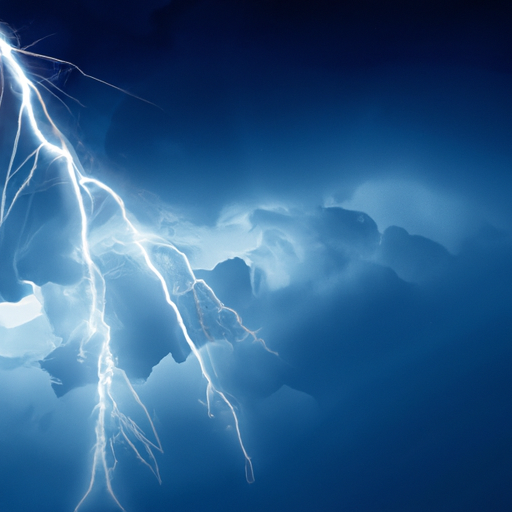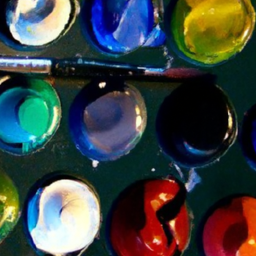Dragons have captivated the imaginations of people for centuries, becoming creatures of wonder and fascination in countless mythologies around the world. From ancient times to modern day, dragons have been depicted as large, dangerous, and mysterious beings that possess a certain allure. These magnificent creatures are often associated with wealth and treasure, adding to their mythical allure. Throughout history, dragons have inspired poetry, literature, and even movies, with their portrayal varying from fierce and terrifying to wise and mystical. Dragon poems delve into various themes, exploring the desire to change or escape one’s nature, the immense power and strength of dragons, and the unending fascination they hold for humans. In this article, we will explore the awe-inspiring world of dragons, examining their enduring presence from myth to modern day.
Dragons in Ancient Mythology
Dragons are popular mythological creatures that have inspired poetry, books, and movies throughout history. These majestic beings have captivated the imaginations of people across different cultures and continents. From ancient Mesopotamia to medieval Europe, dragons have played significant roles in mythology and folklore. In this article, we will explore the rich and fascinating world of dragons, examining their presence in various ancient mythologies, their significance in different cultures, their portrayal in literature and art, as well as their impact on contemporary society.
Mesopotamian Dragons
The ancient Mesopotamian civilization, known as one of the earliest in human history, had its own share of mythical creatures, including dragons. In Mesopotamian mythology, dragons were associated with chaos and destruction, often depicted as fearsome creatures with multiple heads and serpentine bodies. The most notable Mesopotamian dragon was Tiamat, the primeval goddess of the saltwater ocean, who took the form of a dragon. Tiamat represented the forces of chaos, and her defeat by the hero Marduk symbolized the triumph of order and civilization over chaos.
Chinese Dragons
In Chinese culture, dragons hold a revered and benevolent status. These creatures are believed to possess great power, wisdom, and bringer of good fortune. Chinese dragons are often depicted as long, serpentine beings with scales, sharp claws, and majestic horns. They are also associated with the element of water and are believed to have control over rain, rivers, and oceans. The Chinese dragon is a symbol of strength, prosperity, and imperial authority. Their depictions can be seen in various forms of Chinese art, from paintings to carvings and even festival celebrations.
Greek Dragons
According to Greek mythology, dragons were fearsome creatures that guarded treasure or inhabited sacred places. One of the most famous Greek dragons is the Hydra, a many-headed serpent-like monster. The Hydra was known for its regenerative abilities, as whenever one of its heads was cut off, two more would grow back in its place. The Hydra was eventually slain by the hero Heracles as one of his twelve labors. Dragons in Greek mythology symbolized chaos, the unknown, and the trials that heroes had to face in their quests for glory.
Dragons in Medieval Europe
The medieval period in Europe was a time when dragons often appeared in legends and tales, permeating the region’s folklore and cultural imagination. During this time, dragons were often seen as malevolent creatures, associated with evil and chaos. They were depicted as fire-breathing monsters with scaly bodies, sharp teeth, and wings. Many medieval legends revolved around knights and their valiant quests to slay dragons and rescue maidens in distress.
Knight Legends and Dragon Slaying
The image of a knight battling a dragon has become an iconic symbol of medieval lore. Knights were known for their bravery, honor, and chivalry, and their quests to slay dragons were seen as tests of their valor. One such legendary tale is that of Saint George and the Dragon, where the brave knight George rescues a princess by slaying a fearsome dragon. These stories of knights and dragon slaying were often used as allegories, representing the triumph of good over evil and the virtues of righteousness and heroism.
Dragons as Symbols of Evil and Chaos
In medieval Europe, dragons were frequently associated with evil and chaos. They were seen as dangerous creatures that represented the destructive forces in the world. Dragons were often depicted as greedily guarding treasure, symbolizing the corrupting power of wealth and the temptations it brought. They were also believed to be agents of the devil, sent to sow chaos and lead people astray. Legends and stories of dragons served as moral lessons, warning people of the dangers of succumbing to greed, envy, and other vices.
Dragons in Arthurian Legends
The legendary tales of King Arthur and his Knights of the Round Table featured prominently in medieval European folklore. Dragons played a significant role in the Arthurian legends, representing the challenges that the knights had to overcome in order to prove their worthiness. One of the most famous encounters with a dragon in the Arthurian tales is the story of Sir Gawain and the Green Knight. In this story, Sir Gawain faces off against a mysterious and formidable green-skinned knight who transforms into a dragon. This encounter tests Sir Gawain’s bravery, loyalty, and integrity.
Dragons in Eastern Cultures
Dragons have also held a prominent place in the mythology and folklore of Eastern cultures. These awe-inspiring creatures are viewed with reverence and are often associated with wisdom, power, and profound spiritual significance.
Japanese Dragons
In Japanese mythology, dragons, or “tatsu,” are considered to be divine creatures associated with water and rainfall. The Japanese dragon is a symbol of strength, fertility, and good fortune. Unlike the European dragons, Japanese dragons are depicted as serpentine creatures with long bodies, fish-like scales, and beards similar to those of mythical Chinese dragons. The Japanese believe that the appearance of a dragon is a sign of blessings and prosperity. Dragons are commonly depicted in Japanese art, including paintings, sculptures, and even tattoos.
Korean Dragons
In Korean mythology, dragons called “yong” are seen as powerful creatures that are revered as deities and guardians. Korean dragons are believed to have control over the weather, especially rain, and are considered bringers of water and abundance. They are depicted as long and sinewy creatures with elongated bodies, scales covering their bodies, and lustrous manes running down their spines. Much like in Japan, Korean dragons are also associated with good fortune and are considered symbols of nobility and sovereignty.
Dragons in Indian Mythology
In the rich tapestry of Indian mythology, dragons, or “nagas,” hold a significant place. Nagas are serpentine creatures with humanoid upper bodies and snake-like lower bodies. They are considered demigods and are associated with water, fertility, and protection. Nagas are often depicted with multiple heads and crowns, symbolizing their power and status. In Indian myths and folklore, nagas play various roles, from protectors of precious treasures to guardians of sacred sites and as deities associated with fertility and prosperity.
Dragons in Popular Folklore
Dragons have long been fixtures in popular folklore, captivating the imaginations of people across the globe. From the Welsh Dragon to the legendary tale of St. George and the Dragon, these mythical creatures have become an integral part of cultural traditions and storytelling.
Welsh Dragon
The Welsh Dragon, or “Y Ddraig Goch,” has been a symbol of Welsh identity for centuries. This red dragon is often depicted on flags, coats of arms, and other national emblems of Wales. The dragon represents power, strength, and national pride. According to Welsh folklore, the red dragon fought against a white dragon, representing the invading Saxons, symbolizing the eternal struggle between the Welsh and their enemies.
St. George and the Dragon
The story of St. George and the Dragon is a well-known legend in Western folklore. The tale recounts the brave knight, St. George, slaying a fearsome dragon to save a princess and a village from the creature’s terror. St. George is hailed as a hero, and his victory over the dragon represents the triumph of good over evil and the importance of faith and courage. This legend has inspired numerous works of art, literature, and even the iconic statue of St. George and the Dragon in Trafalgar Square, London.
The Lambton Worm
The Lambton Worm is a famous legend from Northeast England, based around a mythical dragon-like creature. The story tells of John Lambton, a young man who catches a strange worm while fishing in the River Wear. He foolishly throws the creature into a well, unaware that it would grow into a monstrous dragon. The Lambton Worm terrorizes the land, wreaking havoc until John Lambton returns and defeats the creature. This legend serves as a cautionary tale, warning against the consequences of one’s actions and the importance of taking responsibility for them.
Dragons in Literature and Art
Dragons’ enduring popularity is evident in their presence in various forms of literature and art. These mythical creatures have captivated the minds of writers and artists alike, inspiring countless stories, poems, paintings, and sculptures.
Dragons in Fairy Tales
Dragons have long been a staple in fairy tales, enchanting readers with their awe-inspiring presence. From the opportunistic dragon guarding princesses, like in “Sleeping Beauty” and “The Brothers Grimm” tales, to the friendly dragon companions found in modern fantasy literature, such as in Cressida Cowell’s “How to Train Your Dragon” series, these creatures have become beloved characters in the world of fairy tales. They often serve as symbols of challenges to be overcome, teaching important life lessons and providing thrilling adventures along the way.
Dragons in Tolkien’s Middle-Earth
J.R.R. Tolkien’s literary works, particularly “The Hobbit” and “The Lord of the Rings” trilogy, have become iconic examples of dragon-centric storytelling. Tolkien’s dragons are menacing and power-hungry creatures that hoard treasures and terrorize the inhabitants of Middle-Earth. The most notable dragon in Tolkien’s works is Smaug, who guards the Lonely Mountain in “The Hobbit.” Smaug’s cunning and fiery nature make him a formidable foe, and his defeat plays a pivotal role in the overall plot. Tolkien’s dragons embody the themes of greed, heroism, and the tests of character faced by the protagonists.
Dragons in Game of Thrones
The popular book series “A Song of Ice and Fire” by George R.R. Martin and its television adaptation, “Game of Thrones,” have introduced dragons to a new generation of fans. In this epic fantasy world, dragons were believed to be extinct until they were hatched by Daenerys Targaryen, one of the story’s central characters. The dragons in Game of Thrones are awe-inspiring creatures with immense power and intelligence. They symbolize the return of magic, the shifting tides of power, and the awe-inspiring potential for change within the story’s complex political landscape.
Dragons in World Religions and Symbolism
Dragons have also found their way into religious traditions and hold symbolic significance in various belief systems around the world. From Christianity to Buddhism and Hinduism, these mythological creatures are seen as representations of cosmic forces and spiritual concepts.
Dragons in Christianity
Dragons are mentioned in various religious texts and folklore within Christianity. In the Bible, “the dragon” is used as a symbol for Satan or evil forces. The book of Revelation describes a vision of a dragon battling against the archangel Michael, representing the eternal struggle between good and evil. Dragons in Christian art often signify the triumph of Christianity over paganism or portray the virtues that believers should aspire to, such as courage and faith.
Dragons in Buddhism
In Buddhism, dragons, known as “nagas,” are important beings associated with water, protection, and wisdom. They are often depicted as expansive and powerful creatures. In Buddhist art, nagas are shown as divine beings, coiling around statues and sacred sites, guarding the teachings of the Buddha. Nagas are seen as bridge-builders between the earthly and celestial realms, symbolizing the connection between spiritual and worldly wisdom.
Dragons in Hinduism
Dragons, or “nagas,” also hold significant roles in Hindu mythology and religious beliefs. Hindu dragon mythologies often depict nagas as deities or semi-divine beings associated with water and fertility. They are often seen as protectors and bringers of wealth and abundance. Nagas are worshiped in Hindu temples and play a vital role in various Hindu festivals and rituals. In Hindu art, nagas are portrayed as serpentine beings with multiple heads, usually accompanied by a canopy of cobra hoods and adorned with luxurious jewels.
Scientific and Fossil Evidence
The existence of dragons remains confined to the realm of myths and legends. However, various theories and fossil discoveries have sparked discussions about the possible origins and influences behind the mythical creatures.
Theories on Dragon Origins
Several theories have been proposed to explain the origins of dragon legends. Some suggest that ancient people might have encountered large reptiles, such as crocodiles or monitor lizards, which contributed to the creation of dragon stories. Others believe that the tales of dragons might have been inspired by draco lizards, known for their ability to glide through the air using specialized rib-like structures. Additionally, fossil discoveries of extinct creatures, such as dinosaurs or pterosaurs, have also fueled speculation about their connection to dragon legends.
Fossil Discoveries
The discovery of dinosaur fossils and other prehistoric reptiles has intrigued scientists and captured the public’s imagination. Ancient creatures like Tyrannosaurus rex and pterodactyls exhibit features reminiscent of dragon depictions in mythologies. While these findings do not prove the existence of dragons as portrayed in ancient tales, they provide a fascinating connection between the natural world and human imagination. The fascination with dragon-like creatures remains, as fossils continue to be unearthed, shedding light on the incredible diversity of prehistoric life.
Explanations for Dragon-Like Creatures
The incorporation of dragon imagery and legends across different cultures raises questions about the potential cultural exchange and shared symbolism. Some experts argue that the similarities between dragon myths around the world may be attributed to the collective human fascination with powerful, elusive creatures. Others suggest that cultural diffusion through trade and exploration might have contributed to the spread of dragon motifs. Regardless of their origins, dragons continue to captivate our collective consciousness and remain an enduring symbol of mystery and enchantment.
Dragons in Modern Popular Culture
Dragons have remained an enduring presence in modern popular culture, finding their way into movies, TV shows, video games, and fantasy novels. These contemporary representations reflect the ongoing fascination and love for these mythical creatures.
Dragons in Movies and TV Shows
Dragons have served as central figures in numerous movies and TV shows, captivating audiences with their awe-inspiring presence. Films such as “How to Train Your Dragon,” “The Hobbit” trilogy, and “Pete’s Dragon” feature dragons as main characters, showcasing their unique personalities and relationship with humans. TV shows like “Game of Thrones” and “Merlin” have also brought dragons to the small screen, depicting them as powerful, intelligent creatures that shape the storyline and contribute to the show’s popularity.
Dragons in Video Games
Dragons have become iconic figures in the world of video games, providing players with thrilling adventures and challenges. From classic games like “Dragon’s Lair” to modern titles like “The Elder Scrolls V: Skyrim” and “Dark Souls,” dragons often serve as formidable foes, requiring strategy and skill to defeat. Many games also allow players to develop relationships with dragons, either as companions or as mounts, enhancing the gameplay experience and fostering a deeper connection with these legendary creatures.
Dragons in Fantasy Novels
Fantasy literature has long embraced the presence of dragons, weaving enchanting tales that capture readers’ imaginations. Novels like Anne McCaffrey’s “Dragonriders of Pern” series, Robin Hobb’s “The Realm of the Elderlings,” and Christopher Paolini’s “Inheritance Cycle” explore the mythical creatures’ relationships with humans and the complex worlds they inhabit. Dragons symbolize power, transformation, and the uncharted realms of magic and adventure. They continue to serve as beloved characters in the genre, inspiring readers and igniting their sense of wonder.
Dragons in Contemporary Art
Dragons have transcended their mythical origins to become a prominent subject matter in contemporary art. Artists around the world have used various mediums to capture the essence and allure of these legendary creatures.
Dragon Sculptures and Paintings
From intricate sculptures in fine art galleries to vibrant murals on city walls, dragon-themed artworks showcase the creativity and skill of artists. Artists utilize different materials, such as metal, wood, stone, and clay, to breathe life into their dragon sculptures, capturing their ferocity and majesty. Paintings often portray dragons in fantastical landscapes, with swirling skies and mystical surroundings. These artworks demonstrate the enduring fascination with dragons and their ability to evoke a sense of awe and wonder.
Dragons in Tattoo Art
Dragons have become a common motif in tattoo art, representing strength, power, and personal transformation. Tattoos featuring dragons range from intricate black and white designs to vibrant, colorful compositions that adorn the body like a protective armor. Dragon tattoos often symbolize personal growth, bravery, and the overcoming of challenges. They serve as striking and meaningful pieces of body art, reflecting the enduring appeal and timeless allure of these mythical creatures.
Dragons in Street Art
The urban landscape has become a canvas for artists to bring dragons to life through street art. Graffiti murals featuring dragons can be found in cities worldwide, captivating passersby with their vivid colors and dynamic compositions. These artworks engage with the public, adding a touch of magic and fantasy to the concrete jungles. Street art dragons represent the artistic expression of contemporary culture, often confronting societal issues or simply providing a visually stunning experience for all to enjoy.
The Impact of Dragons on Society
Dragons have had a profound impact on society, shaping our collective consciousness and influencing various aspects of our lives. From their symbolic meanings to their influence on fashion and advertising, dragons continue to resonate with people around the globe.
Dragons as Symbols of Power and Strength
Dragons have long been associated with power, strength, and the quest for glory. In popular culture, dragons often symbolize the hero’s journey, representing the challenges and trials that individuals must overcome to achieve greatness. The image of a dragon has been used in branding and iconography to convey a sense of authority, resilience, and dominance. The allure of dragons as symbols of power has influenced various aspects of society, from politics to sports teams and corporate logos.
The Influence of Dragons on Fashion
Dragons have made their mark in the world of fashion, inspiring and influencing designers’ creations. Dragon motifs can be found on clothing, accessories, and even footwear, lending a touch of mystique and allure. From intricately embroidered dragon patterns to dragon-themed jewelry, these designs evoke a sense of fantasy and adventure. The dragon’s association with strength, power, and transformation has made it a sought-after symbol in the fashion industry, appealing to those who wish to embody these qualities.
Dragons in Advertising
The imagery of dragons has been utilized in various advertising campaigns to capture attention and convey a sense of excitement and wonder. Whether promoting a movie, a product, or a destination, dragons have the ability to spark curiosity and capture the imagination. Advertisements featuring dragons often tap into the mythical creature’s allure, inviting audiences to experience a world of adventure, power, and endless possibilities. The iconic imagery of dragons serves as a powerful marketing tool, drawing consumers in with the promise of a transformative experience.
In conclusion, dragons have transcended time and geography, captivating the minds and hearts of people across cultures and continents. From their ancient origins in Mesopotamian and Chinese mythologies to their enduring presence in contemporary art and popular culture, dragons continue to inspire and fascinate us. These mythical creatures represent power, strength, and the unfathomable mysteries of the world. Whether appearing in ancient tales, adorning works of art, or influencing the latest blockbuster movie, dragons have left an indelible mark on our collective consciousness, reminding us of the enduring power of myth and storytelling. So let our imaginations soar, for dragons exist in the realm of legends and dreams, forever entwined in the tapestry of human history.



